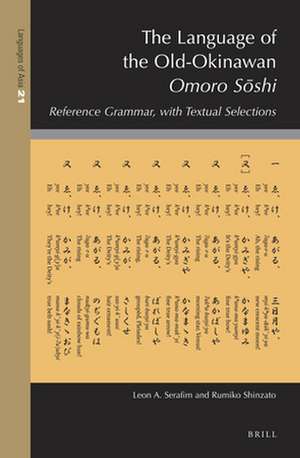The Language of the Old-Okinawan <i>Omoro Sōshi</i>: Reference Grammar, with Textual Selections: Languages of Asia, cartea 21
Autor Leon A. Serafim, Rumiko Shinzatoen Limba Engleză Hardback – 3 mar 2021
Meshing Western linguistic insight with existing literary/linguistic work in Ryukyuan studies, and incorporating their own research on Modern Okinawan, the authors offer a grammar and phonology of the Omoro language, with selected (excerpts of) songs grammatically analyzed, phonologically reconstructed, translated, and annotated.
Din seria Languages of Asia
- 18%
 Preț: 1085.61 lei
Preț: 1085.61 lei - 23%
 Preț: 590.08 lei
Preț: 590.08 lei - 18%
 Preț: 789.42 lei
Preț: 789.42 lei - 18%
 Preț: 778.46 lei
Preț: 778.46 lei - 18%
 Preț: 576.44 lei
Preț: 576.44 lei - 18%
 Preț: 853.41 lei
Preț: 853.41 lei - 18%
 Preț: 904.67 lei
Preț: 904.67 lei - 18%
 Preț: 906.62 lei
Preț: 906.62 lei - 23%
 Preț: 526.98 lei
Preț: 526.98 lei - 18%
 Preț: 1087.85 lei
Preț: 1087.85 lei - 18%
 Preț: 1089.95 lei
Preț: 1089.95 lei - 18%
 Preț: 763.68 lei
Preț: 763.68 lei - 18%
 Preț: 1529.94 lei
Preț: 1529.94 lei - 18%
 Preț: 531.16 lei
Preț: 531.16 lei - 18%
 Preț: 852.65 lei
Preț: 852.65 lei - 18%
 Preț: 630.70 lei
Preț: 630.70 lei - 18%
 Preț: 652.96 lei
Preț: 652.96 lei - 23%
 Preț: 530.48 lei
Preț: 530.48 lei - 19%
 Preț: 422.23 lei
Preț: 422.23 lei - 19%
 Preț: 425.05 lei
Preț: 425.05 lei - 19%
 Preț: 520.53 lei
Preț: 520.53 lei
Preț: 941.61 lei
Preț vechi: 1148.30 lei
-18% Nou
Puncte Express: 1412
Preț estimativ în valută:
180.18€ • 185.88$ • 150.36£
180.18€ • 185.88$ • 150.36£
Carte indisponibilă temporar
Doresc să fiu notificat când acest titlu va fi disponibil:
Se trimite...
Preluare comenzi: 021 569.72.76
Specificații
ISBN-13: 9789004414693
ISBN-10: 900441469X
Dimensiuni: 155 x 235 mm
Greutate: 0.75 kg
Editura: Brill
Colecția Brill
Seria Languages of Asia
ISBN-10: 900441469X
Dimensiuni: 155 x 235 mm
Greutate: 0.75 kg
Editura: Brill
Colecția Brill
Seria Languages of Asia
Cuprins
Preface
List of Figures and Tables
Abbreviations and Conventions
1 Introduction
1What is the Omoro Sōshi?
2Types of omoro
3Versions
4Song Structure
5Overview of the Omoro Language
2 Spelling System and Phonology
1Introduction
2Reconstruction Methodology
3Suprasegmentals
4Consonants
5Processes
6Meter in Omoros
7The Question of External Evidence and Its Relation to That Presented Here
8Coda
3 Lexicon
1PJ Origin
2Loans from MJ
3Loans from Sino-Japanese
4Loans from Korean
5Origins Unknown
6Mishōgo (MO, Meanings Obscure)
4 Nominals
1Nouns
2Pronouns
3Numerals
4Nominal Prefixes
5Nominal Suffixes
5 Adjectives
1What is an Adjective?
2Evolution of Adjectives
3Functional Differences between/among Types
4Functions as Modifiers, Predicates, or Noun Formatives
6 Verbs
1Conjugation Types
2History of Conjugational Merger: ra-gyō yodan-ka
3Functional Split (mz)
4Development of the Gerund
7 Auxiliaries
1Passive/Exalting/Spontaneous -ari(·r)- ~ -uyi(·r)-
2Causative/Exalting -as-
3Negative -azɨ ~ -aɴ ~ -an-
4Negative -adana
5The Optative/Counterfactual Auxiliary -(a)masyi
6Inference/Intention: -aɴ, -a, and -ami
7Negative Inferential/Intentional -umazyi
8Past -syi
9Perfect -t˚ar-, -c˚yar-, -dar-, -ʣyar-
10Emphatic Locative: -ʔac˚ɨr-u
11Progressive: -ur-
12Progressive/Perfective -yaaryi
13Copula: -yar-, -nar-
14The Exalting Auxiliary Verb -(u)wa·r/s-
15Humilific Auxiliary -abir-
16Humilific Auxiliary tʰat°imac°ɨr-
References
Index
List of Figures and Tables
Abbreviations and Conventions
1 Introduction
1What is the Omoro Sōshi?
2Types of omoro
3Versions
4Song Structure
5Overview of the Omoro Language
2 Spelling System and Phonology
1Introduction
2Reconstruction Methodology
3Suprasegmentals
4Consonants
5Processes
6Meter in Omoros
7The Question of External Evidence and Its Relation to That Presented Here
8Coda
3 Lexicon
1PJ Origin
2Loans from MJ
3Loans from Sino-Japanese
4Loans from Korean
5Origins Unknown
6Mishōgo (MO, Meanings Obscure)
4 Nominals
1Nouns
2Pronouns
3Numerals
4Nominal Prefixes
5Nominal Suffixes
5 Adjectives
1What is an Adjective?
2Evolution of Adjectives
3Functional Differences between/among Types
4Functions as Modifiers, Predicates, or Noun Formatives
6 Verbs
1Conjugation Types
2History of Conjugational Merger: ra-gyō yodan-ka
3Functional Split (mz)
4Development of the Gerund
7 Auxiliaries
1Passive/Exalting/Spontaneous -ari(·r)- ~ -uyi(·r)-
2Causative/Exalting -as-
3Negative -azɨ ~ -aɴ ~ -an-
4Negative -adana
5The Optative/Counterfactual Auxiliary -(a)masyi
6Inference/Intention: -aɴ, -a, and -ami
7Negative Inferential/Intentional -umazyi
8Past -syi
9Perfect -t˚ar-, -c˚yar-, -dar-, -ʣyar-
10Emphatic Locative: -ʔac˚ɨr-u
11Progressive: -ur-
12Progressive/Perfective -yaaryi
13Copula: -yar-, -nar-
14The Exalting Auxiliary Verb -(u)wa·r/s-
15Humilific Auxiliary -abir-
16Humilific Auxiliary tʰat°imac°ɨr-
References
Index
Notă biografică
Leon A Serafim, Ph.D. (1984), Yale, was Associate Professor of Japanese at the University of Hawai‘i. He has published articles on Japonic (Ryukyuan and Japanese) (pre)history, and helped edit the Okinawan-English Wordbook and J/K 19. His current interests are, especially, grammaticalization and historical syntax.
Rumiko Shinzato, Ph.D. (1984), University of Hawai‘i, is Professor at Georgia Institute of Technology. She has published chapters/articles on aspect, evidentiality, subjectivity, grammaticalization and language maintenance. She and Leon A Serafim co-authored a book on Okinawan kakari musubi (Brill 2013).
Rumiko Shinzato, Ph.D. (1984), University of Hawai‘i, is Professor at Georgia Institute of Technology. She has published chapters/articles on aspect, evidentiality, subjectivity, grammaticalization and language maintenance. She and Leon A Serafim co-authored a book on Okinawan kakari musubi (Brill 2013).
